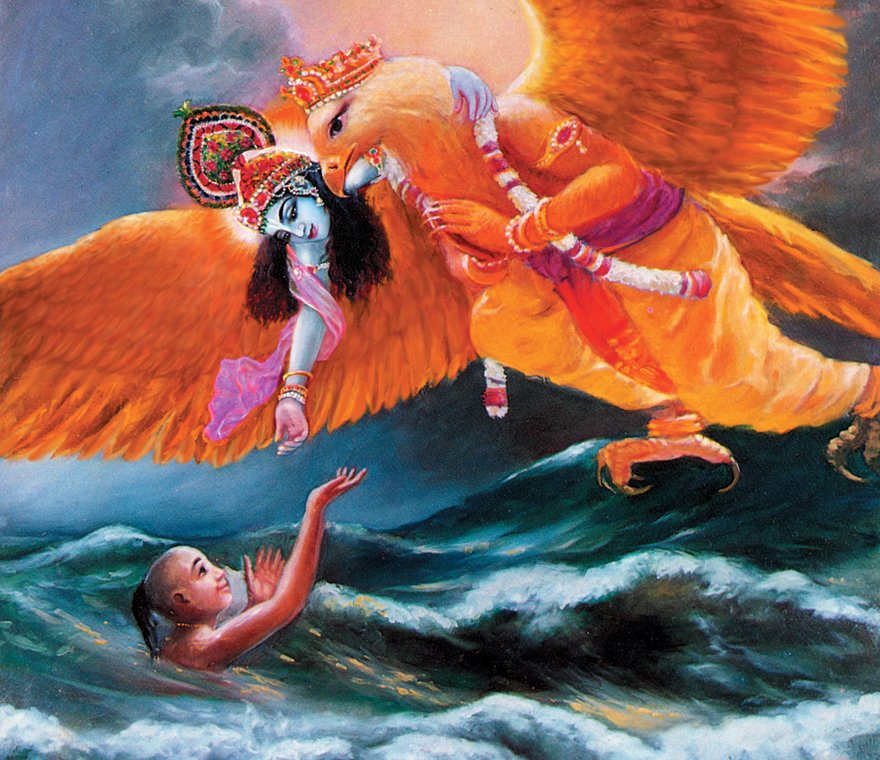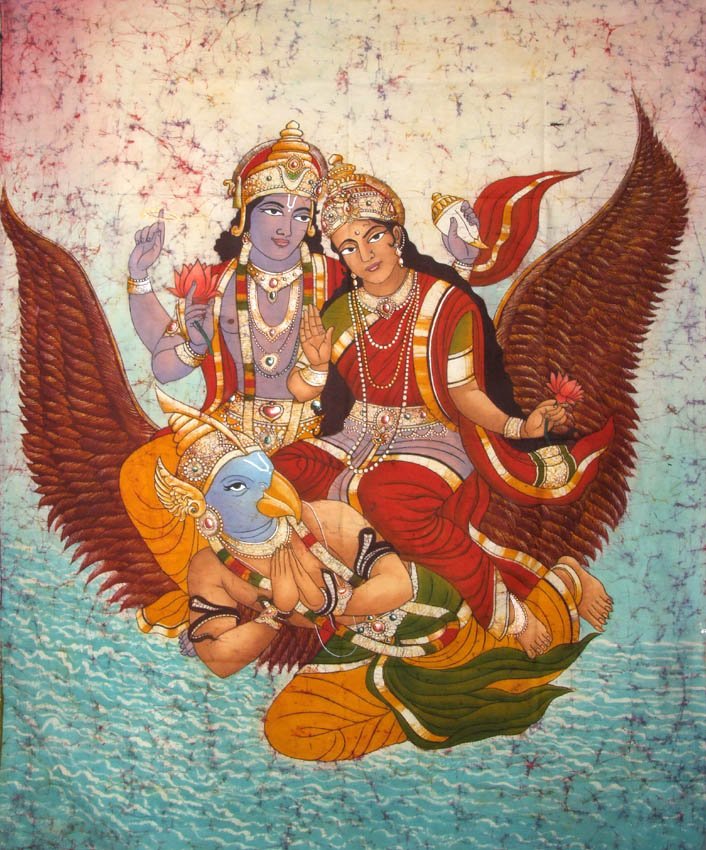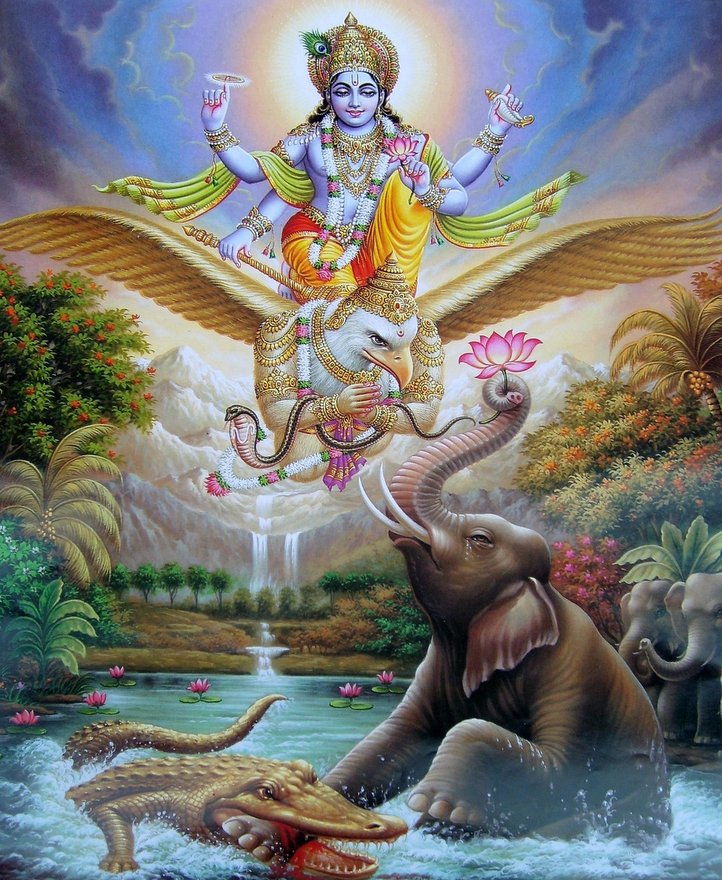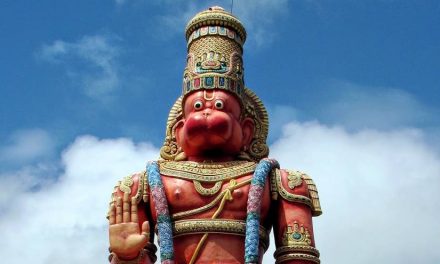The Garuda is a large, “mythical” Eagle, which appears prominently in both Hinduism and Buddhism. Incidentally, Garuda is also the Hindu name for the constellation Aquila.
The Brahminy kite and Phoenix are considered to be the modern representations of Garuda. Garuda is the national symbol of Indonesia – this mighty creature is depicted as a large Javanese eagle.
Namah pannaganaddhaaya vaikunta vasavardhineh
Sruti-sindhu Sudhothpaada-mandaraaya Garutmathe
I bow to Garuda, the One with the beautiful wings, whose limbs are adorned by the mighty serpents, who he has conquered in battle. I bow to the One who is forever in the devotion of his Lord, Vishnu. He is as adept as the Mandara Mountain, in churning the ocean of the Vedas,capturing the very essence of their wisdom.
[wp_ad_camp_1]
In Hinduism, Garuda is an Upadevata, a divine entity, and is depicted as the vahana or mount of Sri Maha Vishnu. Garuda is usually portrayed as being a strong man; having a golden, glowing body; with a white face, red wings, and an eagle’s beak. He is adorned with a crown on his head. This very ancient deity is believed to have a gigantic form, large enough to block out the Surya Devata or the Sun God.
Garuda is widely known to be a permanent and sworn enemy of the Nagas, the ones belonging to the serpent race – it is believed that Garuda fed only on snakes. This behavior bears reference to the short-toed Eagle, which can be found in India. The image of Garuda is often worn as a charm or amulet, as it is believed to protect the wearer from snake attacks and poison.
In fact, Garuda Vidya is the mantra which is often used as a palliative measure to destroy the ill-effects of snake poison and also to remove all sorts of evil the victim has been afflicted with.
Garuda is generally shown as winding the mighty Adisesha serpent on his left wrist and the serpent Gulika on his right wrist. The great serpent Vasuki winds around him to form his sacred thread. Takshaka, the cobra, winds on his hip to serve as a belt. He wears the serpent Karkotaka as his necklace. Further, the snakes Padma and Mahapadma are his earrings. The serpent Shankachuda adorns his hair as a crown.
Garuda is depicted as flanked by his two wives Rudra and Sukeerthi in an ancient Soumya Keshava temple in Bindiganavile in Karnataka state of India. The Importance of Garuda in Hinduism Garuda’s strong position in Hinduism can be estimated by the fact that two ancient Hindu texts, the Garudopanishad and the Garuda Purana, are both dedicated to him.
The Vedas make a mention of Garuda, referring to him as Syena, where this mighty Eagle is adored as the one who brought nectar from heaven to earth. The Puranas also talk about this deed, again equating Garuda with Syena (Sanskrit word for Eagle).
One of the faces of the Panchamukha (five-faced) Hanuman, pointing in the Westerly direction, is that of Mahavira Garuda. Among many Tamil Vaishnava sects, Garuda and Hanuman are referred to as “Periya Tiruvadi” and “Siriya Tiruvadi” respectively.
In the Bhagavad Gita, Krishna, while at the battlefield of Kurukshetra, describes himself as being powerful and omnipresent. He says, “As the son of Vinata, I am the form of Garuda, the King of the birds”.
Krishna and his consort, Satyabhama, are often depicted as riding on Garuda when the former goes to slay Narakasura. Vishnu and Lakshmi are also shown riding Garuda. It is believed that Garuda’s wings chant the Vedas as he flies around the heavens. Garuda has been given various other names, such as Chirada, Khageshwara, Kamayusha, Gaganeshwara, Nagantaka, Kashyapi, Sitanana, Suparna, Tarkshya, Vishnuratha, Vainateya and so on and so forth.
Garuda and Tantra
The Garuda Vyuha is worshipped in Tantra during several Abhichara kriyas, and also used to protect one against Abhichara. Garuda is the Sankarshana energy of the Lord, who is believed to take the manifestation of the omniscient nature of the Lord, during the process of creation. He represents the five vayus that lie within each of us, namely, prana, vyana, udana, samana and brahmana, via each of his five forms, Satya, Supama, Garuda, Tarkshya and Vihageshwara respectively.
The spiritual seeker can attain a stage of Kundalini awakening, resulting in a state of higher consciousness, through the control of these five vayus, with the help of Pranayama.
Birth and Leelas of Garuda
The Mahabharata relates the details of Garuda’s birth. According to this great epic, when Garuda first burst forth from his egg, he appeared as a tremendously brilliant light emitted by a powerful inferno, which could only be equated to the cosmic conflagration that destroys the entire world at the end of every age. Frightened by the sight, the Devas approached Garuda and begged him for mercy. Garuda immediately complied to their request and reduced himself in size and energy.
Garuda’s Enmity with the Nagas
Garuda was born to the sage Kashyapa and Vinata. Kashyapa was also married to Vinata’s sister Kadru. Kadru gave birth to a thousand snakes, who are considered to be the ancestors of all the snakes that can be found on earth today.
One day, Vinata entered into a petty bet with Kadru, regarding the color of the tail of the divine, seven-headed flying horse, Uchaishravas, who emerged during the episode of the Sagar Manthan (Churning of the Ocean of Milk). Kadru claimed that the color of his tail was black, whereas Vinita claimed it was white.
The stake was that whoever lost would become a dasi or slave of the winner. Kadru, who was bent upon winning by any means, asked her sons, the Nagas, to hang onto the tail of the horse, thereby turning it black in color. Thus, the tail which was actually white, turned to black, resulting in Vinata losing the bet and becoming Kadru’s dasi. An arrogant Kadru, along with her sons, treated Vinata very badly, inflicting untold suffering on the latter.
Garuda, enraged by this incident and wanting to release his mother from this bondage, approached the serpents and asked them what he would have to give them in order to purchase her freedom. The Nagas told Garuda that he would have to bring them the Devamrita or Nectar of Immortality in order to free his mother. Garuda knew that this would be a very difficult task to accomplish, as the Devas zealously guarded this elixir, as it was the very source of their everlasting youth and immortality.
The nectar was protectively surrounded on all sides with a fire that covered the entire sky. It was also impossible to access it from above, because it was blocked by means of a fierce-looking and dangerous contraption of sharp rotating blades. Additionally, two gigantic poisonous snakes had been stationed next to the elixir, to further guard it.
Not easily daunted, Garuda surveyed his situation and hastened toward the abode of the Devas, with the intent of stealing the amrita. However, already knowing of his intention, the Gods waged a war against him. Garuda fought valiantly and defeated the entire army and scattered them around in all directions.
He then gathered the water of many rivers in his mouth and poured them onto the protective fires, extinguishing them in one go. Then, making himself really miniscule in size, he swooshed past the rotating blades and entered the area where the amrita was kept. Indulging in battle with the poisonous snakes, he defeated and mangled the two creatures as well. Then, taking the pot of amrita in his mouth, he leapt into the air and headed toward the Nagas who had kept his mother under their control.
En route, Vishnu appeared before him. However, the two did not enter a fight and instead, exchanged promises. Vishnu promised Garuda of immortality without even drinking from the amrita. Garuda, on his part, promised Vishnu that he would become the latter’s mount.
Further ahead, Garuda met Indra and there was another exchange of promises here as well. Garuda promised Indra that once he had delivered the elixir to the Nagas, he would then ensure that Indra regained possession of the Devamrita. Indra, in turn, promised to give Garuda the serpents as food.
Reaching the land of the Nagas, Garuda placed the pot containing the elixir on the grass, and requested them to liberate Vinata from her servitude. He also requested the serpents to perform certain religious rites before going ahead and consuming the Devamrita.
As the Nagas hurried off to perform the said rites, Indra rushed to the place and took away the pot containing the amrita. When the serpents returned, they were aghast to see that the elixir was missing. However, there were small droplets of it on the grass, which they tried to lick off. This made their tongues split in two. Legend has it that this explains why snakes have split tongues and why they also shed their skin as a sign of immortality.
After having fulfilled his mission, Garuda went on to fulfill his promise made to Vishnu. From then on, Garuda became Vishnu’s vahana and also destroyed his perpetual enemies – snakes – whenever he got an opportunity to do so.
Other Legends Related to Garuda
A sparrow once laid her eggs on a sea shore, but the waves carried away the eggs deep into the sea. Very upset by the incident, she asked the ocean to return her eggs. When the ocean did not respond, she single-mindedly started picking out the water in her tiny beak, ignoring the taunts from all around.
Garuda heard about the sparrow’s massive effort and feeling compassion for her, proceeded to help her. Reaching beside the little sparrow, Garuda ordered the ocean to return her eggs, threatening of dire consequences otherwise. The ocean, frightened by Garuda’s threat, returned the eggs safely to the happy, grateful, sparrow.
The flapping wings of Garuda are believed to have formed the basis of the Sama Veda. The two wings of this divine, transcendental Prince of all Divine Vahanas, are believed to be the two branches of the Sama Veda, known as Brihat and Rathantara. Garuda vibrated the Sama Veda to pacify and calm his Lord Vishnu.
Garuda always accompanied his Lord on his most important missions. The mighty bird carried Vishnu to Gajendra, the King of Elephants, when the Lord wanted to save him from the clutches of the deadly crocodile that held onto one of his legs. Vishnu eventually killed the crocodile, thus rescuing Gajendra.
During the Sagar Manthan episode, Vishnu placed the Mandara Mountain on Garuda’s back. He then sat himself on the bird’s back and asked him to take them to the middle of the ocean. Garuda also placed the mountain in the spot as instructed by Vishnu. Vishnu then requested Garuda to leave, as Vasuki, the serpent King, would not enter the region otherwise, fearing Garuda’s presence. Once Garuda left, Vasuki was brought in to act as the churning rod to churn the mighty ocean.
Garuda had great love and devotion for Lord Krishna, an avatar of Lord Shri Maha Vishnu. Lord Indra once sent torrential rain over Vrindavana, the abode of Krishna. It is believed that Garuda, who observed the incident from over the clouds, was so angry and frustrated at Indra’s actions, that he started perspiring profusely.
In another instance, Krishna was fighting with the poisonous snake, Kaliya, trying to subdue him by dancing on his heads. Infuriated by Kaliya’s insolent attitude towards Krishna, Garuda wanted to kill and devour the snake immediately. However, Garuda stopped himself only out of respect for his Lord. Even Krishna warned Kaliya, saying that Garuda would have been powerful enough to kill him, but would not do so only because he saw Krishna’s foot marks on Kaliya’s head.
Once, when Krishna was fighting Brahmasura and his army, Garuda helped his Lord by pecking at the horses and elephants; scratching and gnawing at them with his beak; disturbing them with his swooshing wings. Overwhelmed by the great bird, the animals finally left the battlefield, leaving Brahmasura to fight alone. The asura (demon), realizing Garuda’s great power, struck the bird with all his strength. However, Garuda did not feel even the slightest impact and continued to support his Lord till he won against the asura.
Descendants of Garuda
The Mahabharata states that Garuda has six sons, who gave rise to the entire race of the birds. The members of this race were believed to be very strong and mighty, also completely lacking compassion. They subsisted on snakes, just as their predecessors did and were all under the protection of Shri Maha Vishnu.
Garuda as a Symbol
All through the Mahabharata, Garuda is known to be an impetuous, violent force to reckoned with. He was supremely powerful, able to move at a great speed and also very well-versed in the martial arts.
In fact, the most powerful warriors and fighters are likened to Garuda who swoops down on a serpent. Acharya Drona developed an entire military formation and named it after the mighty bird, Garuda. Garuda also features prominently on Krishna’s banner during the Kurukshetra War.

















Highly informative Thank u very very much.
nicely narrated
NO WORDS OF THANKS TO MAKE US FULLY UNDERSTAND ABOUT LORD GARUDA.
WITH REGARDS
Santhanan
Good
Wow,
Where do you get this lovely and exact images
Very good article. Only that, lets not call him “Mythical”. We have enough pramanas in the vedas and puranas about him.